
Much of search engine optimization (SEO) focuses on building your website in a way that search engines can crawl and index, and then creating helpful content targeting the queries users search. But there’s more to optimizing your website than tweaking the back-end or adding new pages.
A simple, often-overlooked strategy is simple and can be done without writing anything new or diving too deep into the technical side of your site.
Internal linking for SEO involves creating a better experience for users and search engines by connecting two relevant pages.
What is Internal Linking?
Internal links are any links on your website that point to another page on your website. Internal linking is the overall web of these links across your site. They contrast with external links, which send users to a different site.
In HTML, an internal link looks like:
<a href=“https:yoursite.com/”>anchor text (the text that contains the link)</a>
The open <a> tag starts the link, the href contains the page being linked to, and the anchor text follows before the tag is closed.
There are two general types of internal links: contextual and non-contextual. Contextual links are within the content of a page. For example, if your site has a blog on running in cold weather, you could add an internal link to your page about cold weather running gear, with anchor text “cold weather running gear.”
On the other hand, non-contextual internal links are other links on your site such as on your home, navigation menu, or post feed.
Each is necessary to improve user experience and SEO, so you shouldn’t just focus on one or the other.
Why Are Internal Links Important for SEO?
Internal links are important for SEO because they provide unique value for both users and search engines.
For users, they allow them to better navigate the site (non-contextual links), learn more about a particular topic, and find pages farther from the homepage (contextual links). If you are providing helpful content, users may want to learn more from other pages on your site.
If you catch their interest with an internal link on a related topic, you can drive additional page views on your site.
Contextual and non-contextual links are also critical to your conversion funnel. Most sites have a goal in mind for when a user visits, whether that’s to call and set up an appointment for home services, fill out a contact form, or request a demo of a SaaS offering.
But it can also be difficult to convert users if they only view one page of your site. It may take them learning more about your site, and landing on the right pages, in order to convince them to convert.
For search engines, links are how it crawls the web. Search engines like Google crawl links from one page to another to find and index the content, so make sure all the pages on your site are linked to at least once to help with indexing. An “orphaned page” on your site without a link pointing to it may never get found.
How to Audit Your Site’s Internal Links
Before you start adding new internal links on your site, it’s helpful to see where your site currently stands with its linking.
There are two easy ways to analyze your site’s internal linking SEO performance: Screaming Frog and Google Search Console.
Auditing Links with Screaming Frog
Screaming Frog crawls your website and provides technical data such as metadata, response codes, and links, both internal and external. Its free version lets you crawl up to 500 URLs.
Crawl to See Number of Inlinks and Unique Inlinks
Search the Place the homepage of your site in the search bar, crawl the site, and move “Unique Inlinks” and “Inlinks” so it’s next to “Status Code” on the far left of the crawl.
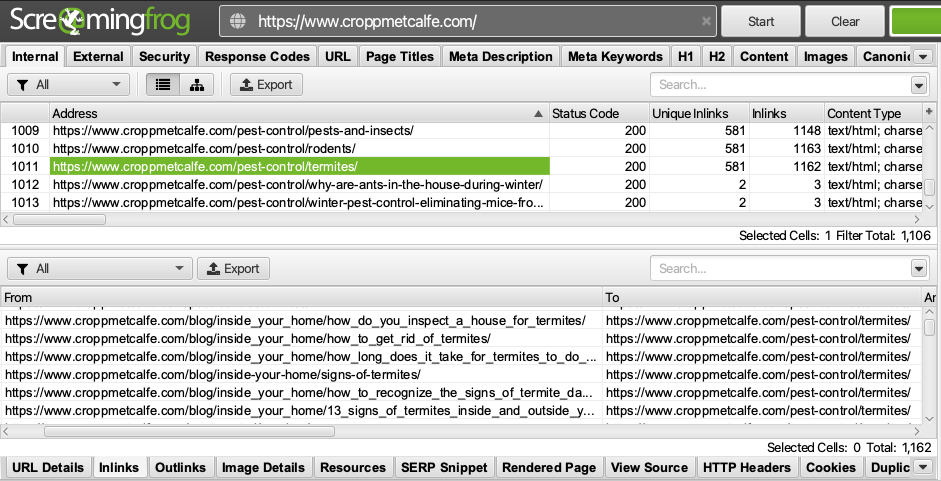
Unique inlinks means it only counts one link, even if page A links to page B five times. Inlinks are the total number of links coming to that page, so in the example of pages A and B, B would get five inlinks from A. In the example above, CroppMetcalfe has 1162 Inlinks to their termites pest control page, with 581 being Unique Inlinks.
Identify if Priority Pages Have the Most Inlinks
For the sake of auditing, we’ll focus on inlinks and not unique inlinks. Check if your priority pages have the highest number of inlinks and if any pages are mismatched in terms of their importance relative to the number of inlinks.
For example, if a high-value conversion page only has four inlinks, but an upper-funnel blog not generating much traffic has 30, you might want to add links to the conversion page and hold off on adding any more to the blog.
It’s likely the pages in your main navigation, especially your homepage, will have the most links. This is normal and not something you need to adjust, because pages in your navigation technically have a link from every page. It’s just a non-contextual one.
See From Which Pages Inlinks Are Coming
To check if your internal linking makes sense contextually (meaning pages link to relevant pages), you can check which of your pages are linking to any particular page.
Click on the URL in the “Address” column, and then at the bottom of the page, click the “Inlinks” tab.
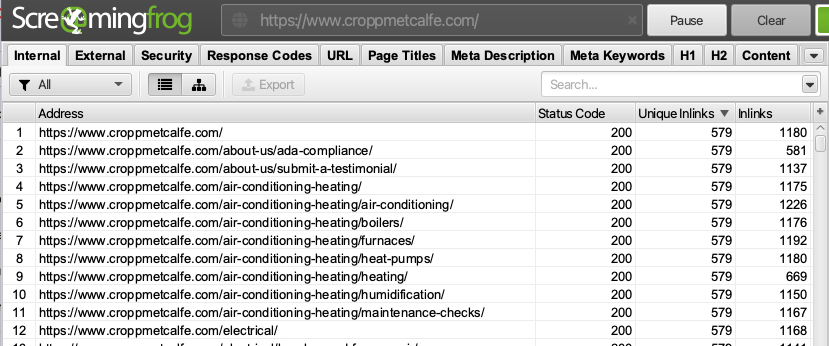
But if you find many instances where pages on your site are linked together without topical relevance to each other, there may be opportunities to better silo similar content together by removing links.
Check Anchor Text
You can also look at the anchor text for each link and ensure it accurately represents the content of the page. In the same tab used to check inlinks, scroll to the right to the column labeled “Anchor Text.”
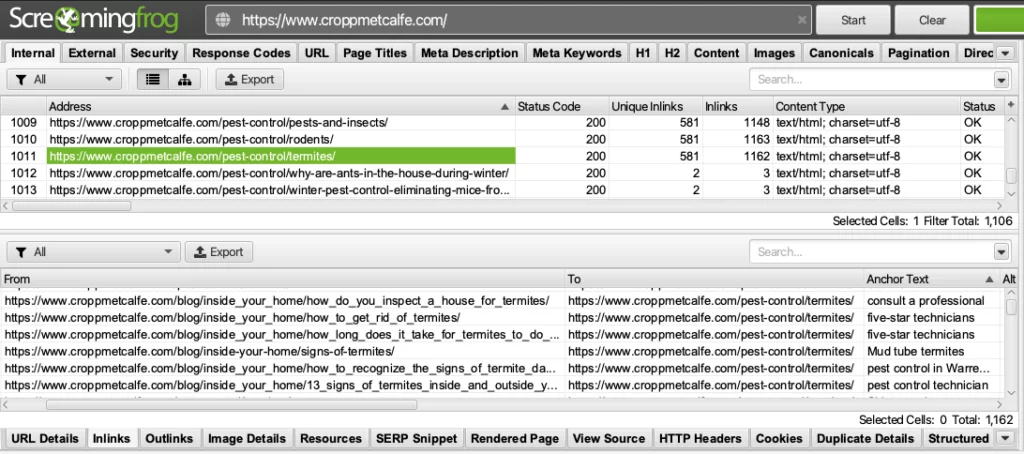
In the example above, many of CroppMetcalfe’s blog pages link to their termite pest control service page, using relevant anchor text like “mud tube termites” and “pest control in Warrenton”.
Auditing Links with Google Search Console
Google Search Console (GSC) is a free tool from Google that mostly serves to help with the technical side of your site and making sure it’s indexed.
It includes a tool showing your site’s top internally linked pages.
Click “Links” in the sidebar, and on the right side of the dashboard, you can see which pages are linked to on your site most often.
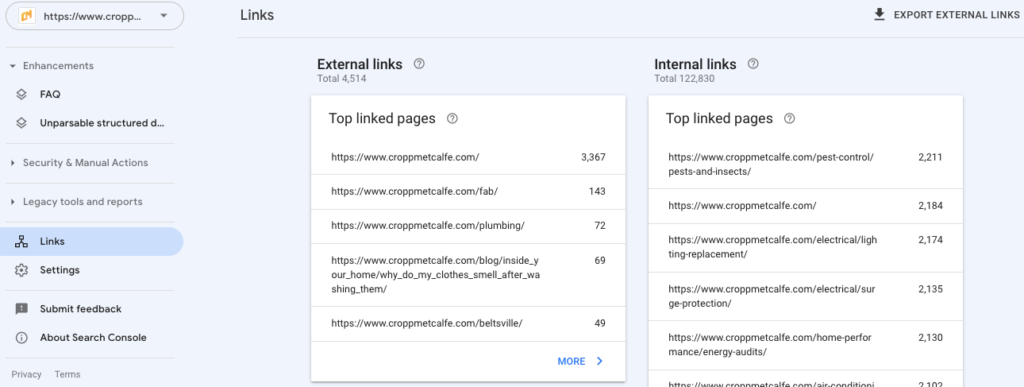
Click on a URL, and you’ll be shown which pages on your site link to that page.
It doesn’t provide as much detail as Screaming Frog, but it’s a quick way to see which of your pages get the most internal links, and from there, you can make adjustments such as adding or removing links and checking the anchor text of each.
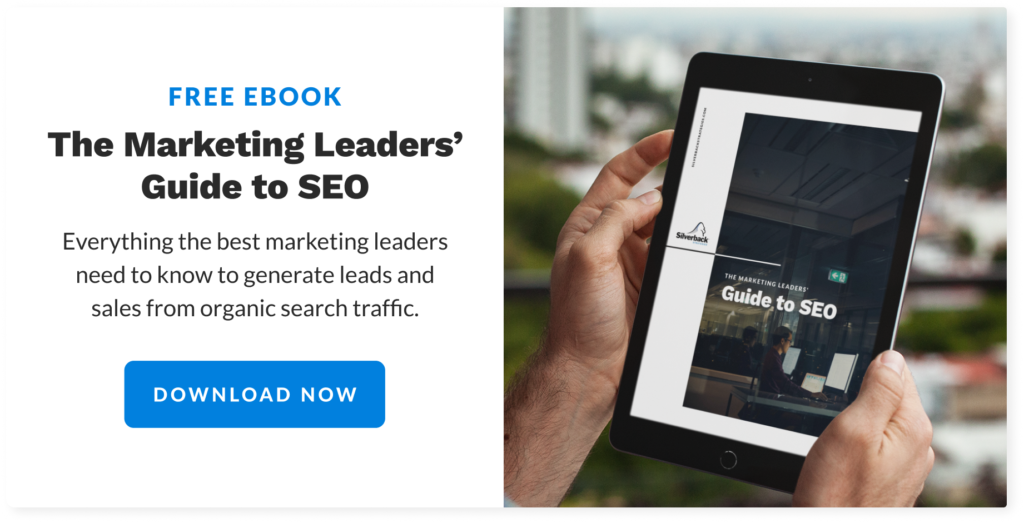
Internal Linking for SEO Best Practices
Once you know the current status of your internal linking profile, it’s time to make changes to improve user experience and SEO. Below are nine best practices for internal linking.
Link Deep Into Your Site
Linking deep into your site means someone should be able to reach every page on your site if they began on the homepage. It’s easy to leave random blog posts high and dry and not give them any links, but then there are two risks: Google will never find the page in the first place; or if Google does find it, the only way someone can land on the page is from search results or a referral from another site.
On a related note, page depth refers to how many clicks a page is away from the homepage. If a user starts on the homepage and needs to click through eight pages to reach a certain page, that page has a depth of eight.
Minimize Page Depth
Ideally, your site should go no more than five layers deep, meaning a user can reach every page on your site within five clicks. Any more than that and there’s minimal chance the page will get any traffic from any source but organic or referral.
It’s also helpful for SEO because it minimizes the effort search engines must use to crawl your whole site. You want to make it as easy as possible for bots to crawl the site, and sending them eight, nine, or 10 layers down isn’t the way. Minimizing page depth also saves on crawl budget. It’s not guaranteed that Google will crawl every page, so if the page depth is high, and if some pages take too long to load, there’s a risk Google will not get to that page or stop crawling and move on.
The key is to keep the architecture of your site logical and organized, where you group similar content together, as opposed to everything or nothing being connected by links.
Use Internal Links for Site Architecture
Site architecture refers to the overall structure and hierarchy of your site. The structure is built through folders and subfolders, connected through internal links.
The key is to keep the architecture of your site logical and organized, where you group similar content together, as opposed to everything or nothing being connected by links. In the example below, K12 has grouped pages around career preparation into five categories:
- About Career Prep
- Programs & Curriculum
- Career Fields
- High School Career Exploration
- Career Prep FAQs
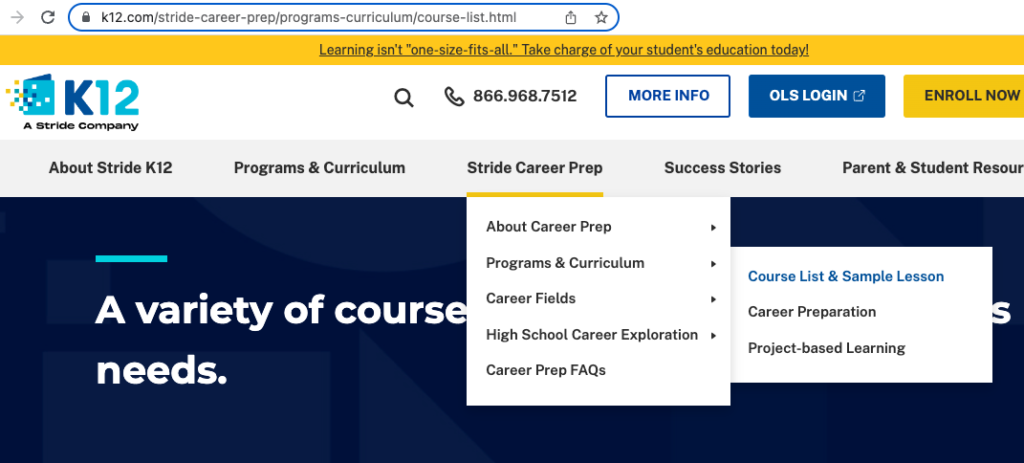
You don’t have to perfectly silo topics, but too much linking between unrelated parts of your site can defeat the point of links sending readers to contextually relevant content and down a given sales funnel.
Keep Links Natural
Internal links should come across naturally to readers. They shouldn’t interrupt the flow of content in a way where you are providing quality content and then stop to pitch the link they should click.
This is where using relevant anchor text comes in. To use our example about running in cold weather, your link to the cold weather gear page could read:
“If you’re planning to go for a run in freezing temperatures, you should have the right cold weather running gear,” (“cold weather running gear” as anchor text).
This is in contrast to an unnatural link such as:
“If you’re planning to go for a run in freezing temperatures, you should have the right cold weather running gear. Click here to view our recommendations,” (“Click here to view our recommendations” as anchor text).
Keep Links Relevant
When it comes to deciding which pages to link to from a given page, put yourself in the mind of the reader. Based on their interest in the current page, what other pages on your site would they visit?
If your site with the page about cold weather running is a general outdoors site, it would make sense to link to other pages about running, but linking from a page about cold weather running to summertime fishing wouldn’t make as much sense.
Use Keyword-Rich Anchor
The anchor text you use should contain the types of keywords you want the linked-to page to rank for. Google uses anchor text as a signal for what that page is about, so by using your target keyword or a phrase containing it, you’re giving Google an additional hint.
So if you have a site for dog owners with pages about how to care for a golden retriever and the best dog food for golden retrievers, your link to the latter page should include a variation of the phrase “dog food for golden retrievers.”
That gives a clear signal to the user and Google about what they should expect on the page.
Balance this best practice against the idea you don’t want internal links to come off as spammy. Overusing keywords in your anchor text to where it isn’t natural can have the opposite effect.

Don’t Use the Same Anchor Text for Multiple Pages
On a related note, you want to avoid using the same anchor text to point to different pages. Because anchor text is a signal to Google about what content to expect, it would be confusing if the anchor text “moving a grand piano” pointed on one occasion to a page about moving a grand piano and on another occasion to a page on moving tips in general.
Send More Links to Important Pages
You should identify the most important pages on your site and make sure you have more links pointing to those pages.
There’s not an exact science in terms of the ratio of these links to lesser important pages, but make sure things aren’t the complete opposite of what you’d want — where you have dozens of links to upper-funnel blogs and few to your critical service and conversion pages.
Use Dofollow Links
“Dofollow” links, in contrast to “nofollow,” tell search engines to crawl the link. Dofollow is the default, so when it comes to making sure your links are dofollow, it really means not proactively adding rel=“nofollow” to a link.
The reason you want to leave your links as dofollow is because you want search engines to crawl the link in order to find the linked-to page and pass SEO value from the current page to the link-to page.
Connect with Silverback to Increase Your Search Traffic
As a website visitor, you may not think much about internal links on a site, but it’s a key user experience and SEO strategy to take advantage of by strategically giving users and search engines the opportunity to visit more pages.
At Silverback Strategies, we’re a team of digital marketing experts with experience in SEO campaigns across a variety of verticals. We identify the content your site needs to rank for relevant keywords and ensure your site is built for search engines to crawl and index — including your internal linking strategy.
Contact Silverback today to learn how we can partner with you to grow your business online.
Recent Posts
The Evolution of SEO Content: Building Sustainable Strategies with AI
Read the ArticleThe Ongoing SEO Process: Tips + Best Practices
Read the ArticleWhy You Need Audience Research in SEO
Read the Article
Unlock Your Growth Potential
Silverback helps businesses catapult web traffic, leads, and sales. We combine analytical and creative expertise to drive inbound marketing campaigns and track it all to find insights on what worked, what didn’t, and what we should try out next.
Contact Us